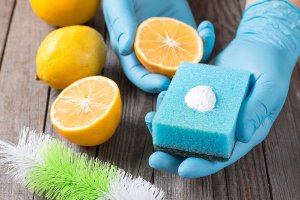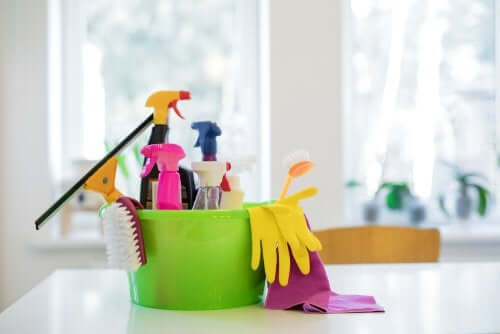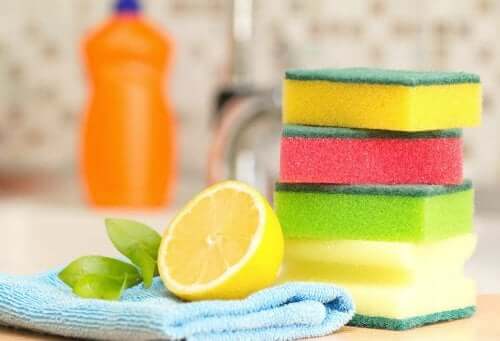Are Cleaning Chemicals Harmful?

You’ve probably heard that cleaning chemicals are harmful to our health. Some elements, such as chloroform, formaldehyde, or phthalate can cause serious illnesses in children, adults, and even pets. Below, we’ll share a list of the most harmful ones and how to replace them.
Scientific data is clear: More than half of the products sold in supermarkets and stores contain harmful ingredients. Therefore, the main consequences of their continued exposure are allergies and respiratory problems.
Harmful cleaning chemicals according to science

In 2012, the Environmental Working Group (EWG) analyzed the most common household liquids and cleaning products. The results were alarming. They found approximately 65 highly toxic substances that are frequently associated with infertility, endocrine disorders, general malaise, or neurotoxic diseases.
In Norway, the Department of Clinical Science at the University of Bergen conducted a study based on monitoring 6,000 people who used cleaning chemicals daily. This study emphasized the damage to the respiratory system of people who were exposed to these toxic elements.
Moreover, the Accepted Nature Climate Change study at Harvard University focused on the damage that these substances imply for the environment as a whole. Symptoms such as anemia or iron deficiency would derive from the contamination that results from cleaning chemicals.
Also, the United States Environmental Protection Agency (US EPA) mentioned that people coexist daily with the chilling figure of 150,000 highly harmful synthetic substances.
You may like this article: 4 Toxin-Free Cleaners for Your Home
Toxic substances in cleaning chemicals
There are countless toxic chemicals found in cleaning supplies. However, we’ll focus on some of the worst and most common culprits:
- Phthalates. These make up cleaning products with synthetic perfumes. Overall, their main risk is that they’re possible endocrine disrupters. Dishwashing liquid, floor or furniture cleaners, toilet paper, and even personal hygiene items may contain them.
- Perchloroethylene. This is present in “dry cleaning” products. Overall, this component can cause anything from dizziness to respiratory and eye irritations, as it’s considered a neurotoxic agent. Carpet cleaners and stain removers, among other products, contain it.
- Triclosan. Dishwashing liquid contains this chemical In fact, it’s even been banned in the United States for causing antibiotic-resistant bacteria. On the other hand, it’s extremely detrimental to natural ecosystems.
- Likewise, there’s quaternary ammonium compounds (QAC). Like triclosan, it’s listed on labels as an “antibacterial”. The truth is that its prolonged use may cause conditions such as dermatitis and respiratory allergies. You can find it in fabric softeners and various disinfectants.
- Finally, there’s butoxyethanol. This belongs to the family of solvents and is presented as an effective multipurpose cleaner. Its daily use affects everything from the lungs to the liver and kidneys.
This article may interest you: The 5 Best Cleaning Solutions Using Baking Soda and Vinegar
Risk-free cleaning alternatives

First, it’s crucial to keep in a mind a few basic tips:
- Stop using all spray cleaners and ventilate your home for a long time after cleaning.
- Moreover, you should wear gloves to avoid poisoning.
- Likewise, wear protective masks when you clean with them.
All precautions are valid to prevent contaminated air from entering the lungs or coming into contact with the skin. Also, don’t forget that there are many effective tricks to apply in home cleaning.
You can replace cleaning chemicals without affecting the cleanliness of your home. Actually, the best option is homemade toxic-free ecological alternatives. However, if you intend to buy cleaning products without chemicals, perhaps you’ll need to make a greater investment.
On the other hand, you can do most of the cleaning with a clean cloth, water, and some soap. If you can’t avoid using cleaning chemicals, it’s essential to remember not to use them around certain people. For example, children, the elderly, or vulnerable people, such as pregnant women may all be especially vulnerable.
In conclusion, cleaning chemicals enter the body mainly through the respiratory tract, skin, and eyes. Thus, you have to use them responsibly and always being aware of their components. Finally, remember to always read the labels and take your health into account.
All cited sources were thoroughly reviewed by our team to ensure their quality, reliability, currency, and validity. The bibliography of this article was considered reliable and of academic or scientific accuracy.
- Nazaroff, W. W., & Weschler, C. J. (2004). Cleaning products and air fresheners: Exposure to primary and secondary air pollutants. Atmospheric Environment. https://doi.org/10.1016/j.atmosenv.2004.02.040
- Al-Amoudi, A., & Lovitt, R. W. (2007). Fouling strategies and the cleaning system of NF membranes and factors affecting cleaning efficiency. Journal of Membrane Science. https://doi.org/10.1016/j.memsci.2007.06.002
- Shugar, G., Ballinger, J., Application, I., Glass, A. O., Dilute, A. M., & Not, D. O. (1996). Cleaning procedures for glass substrates. Chemical Technicians’ Ready Handbook.
This text is provided for informational purposes only and does not replace consultation with a professional. If in doubt, consult your specialist.








